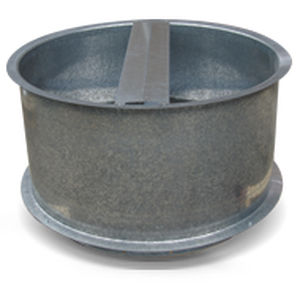
Air vent FLANGED VERTICAL DISCHARGE COWLS

Add to favorites
Compare this product
Description
The Flanged Vertical Discharge Cowls are ideal in ducted systems where the fan is mounted remotely below roof level.
They work together with a mechanical exhaust system while preventing the entry of rain when not in use. These durable and robust units are designed for mounting on circular duct and flue discharges using a flange.
There are 11 sizes in the range handling air flows from 0.2 to 55 m3/s.
Features
Enables the vertical discharge of air while preventing rain from entering building.
Steel components have a corrosion resistant finish.
Fitted with reliable gravity air-operated backdraft shutters.
Construction
Backdraft shutters:
Sizes 40 to 80 - Made from aluminium.
Sizes 100 & 180 - Made from galvanised sheet steel.
Cowls are of galvanised steel.
Fitted with gravity air-operated backdraft shutters.
Steel components have a corrosion resistant finish.
Special Note
Flanged Vertical Discharge Cowls are designed for relatively high air discharge velocity. At low discharge velocities, rain could enter the building. For these types of applications an Alpha Relief Air Vent is recommended.
For any application where prevailing winds may lift the shutters of the Flanged Vertical Discharge Cowl, we recommend the fitting of Magloks®.
Ensure the hinge of the shutter points down the slope of the roof.
Suggested Specification
The vertical discharge cowls shall be of the RVF series as designed and manufactured by Fantech Pty Ltd.
Each unit shall incorporate gravity air-operated backdraft shutters that are constructed from aluminium or galvanised sheet steel.
Cowls are of galvanised steel and steel components shall have a corrosion resistant finish.
Catalogs
No catalogs are available for this product.
See all of Fantech‘s catalogsRelated Searches
- Metal exhaust fan
- Commercial exhaust fan
- Indoor exhaust fan
- Extractor exhaust fan
- Residential exhaust fan
- Duct exhaust fan
- Plastic exhaust fan
- Ceiling-mounted fan
- Axial exhaust fan
- Industrial exhaust fan
- Centrifugal exhaust fan
- Wall-mounted exhaust fan
- Acoustic exhaust fan
- Galvanized steel exhaust fan
- Steel exhaust fan
- Aluminum exhaust fan
- Roof fan
- Jet nozzle
- Air supply vent
- Roof exhaust fan
*Prices are pre-tax. They exclude delivery charges and customs duties and do not include additional charges for installation or activation options. Prices are indicative only and may vary by country, with changes to the cost of raw materials and exchange rates.

